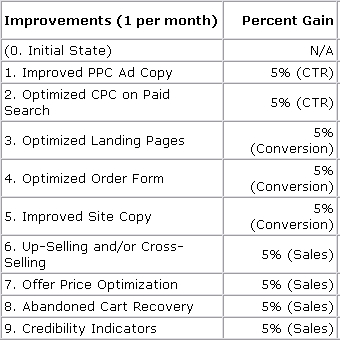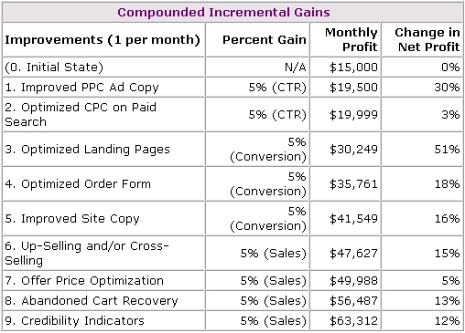Online marketing and sales functions are often divided up between different people, groups, or even offices.
One person watches over pay-per-click (PPC) optimization, another handles outbound emails, another is responsible for the text on the home page, while another group entirely is working on the site's shopping cart.
If you have worked for an organization of any size, you probably know what I mean.
All of these individuals or groups work to make improvements in their own areas of responsibility: The person working on PPC is hoping to find some new keywords or headlines that will increase ROI by 50%. The copywriter is hoping to write a killer headline and double the number of people who click the Buy button.
And so on.
However, while each individual works hard to achieve a breakthrough increase in performance, the group as a whole often remains unaware of how much can be achieved over time through small micro-gains along the entire marketing and sales pathway.
Remember what your investment adviser told you about the power of compounding?
It's the favorite promise of anyone selling investments: Start putting money aside early, and the compounding effect will make you a millionaire by the time you retire.
And it's true. (If you start early enough and put aside enough in the early years.)
The exact same principle applies to marketing.
As an example, let's consider a nine-month time frame. And we'll make a small improvement to a particular step in our marketing and sales process each month.
To illustrate the power of the compounding effect with micro-gains, we'll confine our increases to 5% across the board.

Over the first two months, we are working on increasing the effectiveness and ROI on our PPC campaigns.
For the next three months we are working on the site to improve key conversion pages.
And over the last four months we try some additional tactics to add a few more micro-gains along the pathway.
Five percent doesn't sound like much. Everyone who was working on those individual areas might feel a little disappointed.
But let's look at the results achieved by these modest gains at the end of the nine-month period.

Starting out with a monthly profit of just $15,000 a month at the outset, we finished with our profits at $63,312. That's a gain of $48,312.
Now for some interesting details...
Two factors are at play here.
First is the power of compounding. As you can see, the impact of just small improvements can make a big difference over time. And if you showed this chart to your accountant, he or she would undoubtedly tell you that in the first month you should work on the area most likely to deliver the highest improvement in net profit. The power of compounding comes into its own when the big figures appear in the early months or years.
The next thing to consider is the associated power of leverage.
As you'll see from the table, not every 5% increase delivered the same increase in net profit. For instance, a 5% increase in conversions from the landing page delivered a 50% increase in net profits.
You'll have to do your own math and research to identify where the greatest leverage lies within your own model, and how best to "frontload" the changes most likely to give you the highest increase in net profits.
Some final thoughts...
The table above covers just a nine-month period. And the 5% gain across the board is a very modest target. In our own tests with research partners, we have seen gains of 40%, 50%, or more.
Whatever gains are possible, it is important to see the entire marketing and sales pathway as a whole.
Even if the various processes are fragmented within your company or organization, perhaps one meeting is all it would take to formulate a series of tests and improvements to various elements over the year ahead. Then track the power of leverage and compounding over the next 12 months.
As we have seen, while a 50% increase here and there is to be aimed for and hoped for, even very modest micro-gains of 5% can compound over time to deliver a very significant overall increase in net profits.




